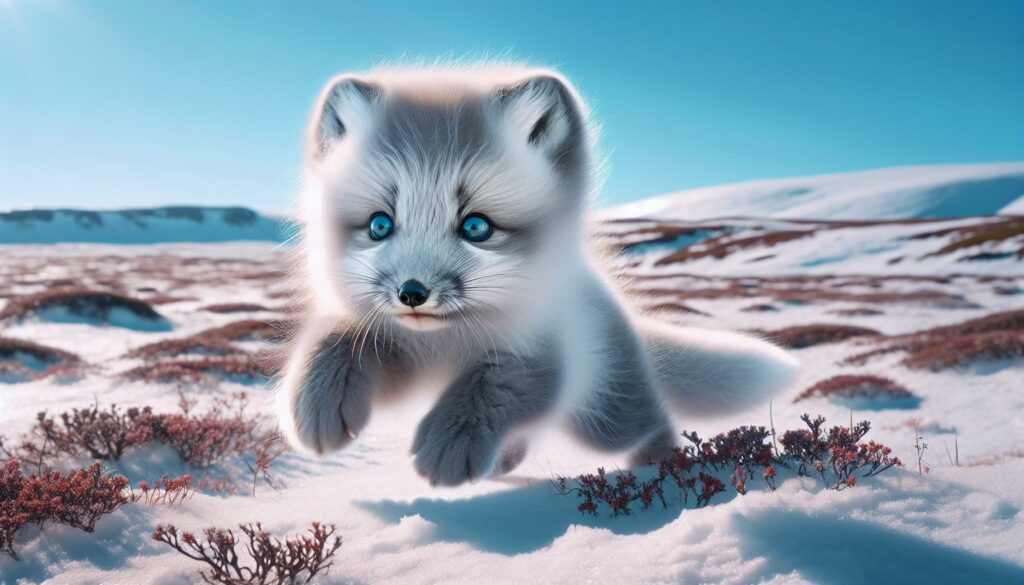When I first stumbled upon the adorable baby Arctic fox, I couldn’t help but fall in love. These tiny creatures, with their fluffy white fur and bright blue eyes, are nature’s little snowballs. Born in the harsh conditions of the Arctic, they embody resilience and charm, capturing the hearts of wildlife enthusiasts everywhere.
In this article, I’ll explore the fascinating world of Baby:xzn4y3oj8tk= Arctic Fox. From their playful antics to their survival skills, these pups offer a glimpse into a life filled with wonder and challenges. Join me as we dive into their unique behaviors, habitat, and the vital role they play in their ecosystem. Whether you’re a nature lover or simply curious about these enchanting animals, there’s much to discover about the baby Arctic fox.
- Physical Characteristics: Baby Arctic foxes, or kits, are born weighing about 1.5 ounces, initially have gray coats that turn white for camouflage, and develop blue eyes that eventually become yellow as they mature.
- Habitat: These adorable creatures thrive in the tundra regions of the Arctic, including Alaska, Canada, Greenland, and Russia, relying on dens for protection from the harsh climate.
- Behavior and Development: Kits engage in playful activities that help them develop essential survival skills like foraging, often mimicking their mother’s hunting techniques during early life stages.
- Diet Needs: A balanced diet for baby Arctic foxes includes small mammals, birds, insects, and vegetation to provide the necessary protein and nutrients for healthy growth.
- Health Care: Regular veterinary check-ups and vaccinations are vital for preventing common health issues such as parasites and nutritional deficiencies, ensuring the well-being of baby Arctic foxes.
- Social Interaction: Encouraging social play with siblings and fostering natural behaviors through enrichment activities are essential for the emotional and physical development of kits.
Baby:Xzn4y3oj8tk= Arctic Fox
Baby:xzn4y3oj8tk= Arctic Fox, with their striking physical features and curious behaviors, capture the attention of many wildlife enthusiasts. Their early life stages present a unique glimpse into the adaptation and survival of these remarkable animals.
General Characteristics
Baby:xzn4y3oj8tk= Arctic Fox, called kits, are born blind and deaf, weighing about 1.5 ounces (40 grams). Their coats begin as a soft gray, transitioning to white in the summer for camouflage. Kits develop bright blue eyes, which change to yellow as they mature. Playfulness defines their early existence, as they engage in pouncing and wrestling, honing their hunting skills. They rely on their mothers for food and warmth during the first weeks of life, growing rapidly in size and strength.
Habitat and Distribution
Baby Arctic foxes inhabit the tundra regions of the Arctic, including parts of Alaska, Canada, Greenland, and Russia. They thrive in open, treeless areas, utilizing dens for shelter and protection from extreme weather. The Arctic’s harsh climate, characterized by freezing temperatures and snow cover, shapes their survival strategies. Kits often roam to explore their environment, developing skills that prepare them for independent living as winter ends.
Behavior and Social Structure
Baby:xzn4y3oj8tk= Arctic Fox exhibit intriguing behaviors that reflect their adaptation to the harsh Arctic environment. Their social structure revolves around family units, primarily consisting of the mother and her kits.
Sleeping and Foraging Habits
Kits typically sleep in dens, which provide warmth and protection from predators. Dens often consist of multiple chambers, ensuring safety during harsh weather. Foraging begins around six weeks old; at this age, kits start to accompany their mother on hunts for small mammals and birds. They play a vital role in learning foraging skills by imitating their mother’s behaviors. Foraging primarily occurs during dawn and dusk when activity levels of prey are highest.
Interaction with Other Species
Kits interact with various species in their habitat, showcasing a complex social structure. They share their territory with other Arctic foxes, which can lead to competitive encounters. Kits often communicate through vocalizations, such as barks and whines, signaling distress or excitement. Their interaction with local birds and mammals helps establish awareness of potential threats and prey availability, which teaches valuable survival strategies. Understanding these interactions enhances their ability to thrive in the Arctic ecosystem.
Care and Maintenance
Caring for baby Arctic foxes involves understanding their dietary needs and providing opportunities for enrichment and play. Proper care helps kits grow into healthy adults, enhancing their survival in the wild.
Diet Recommendations
Feeding baby Arctic foxes requires variety and balance. Kits usually consume a diet rich in protein, which includes:
- Small mammals: Mice, voles, and lemmings are staple foods, providing essential nutrients.
- Birds and eggs: Ground-nesting birds offer both protein and fat, crucial for growth.
- Insects: Beetles and grasshoppers can supplement their diet, especially in warmer months.
- Vegetation: Berries and plant matter can provide carbohydrates, aiding in digestion.
It’s important to mimic their natural diet as closely as possible, ensuring they receive adequate hydration and vitamins.
Enrichment and Play
Providing enrichment for kits is vital for their development. Engaging activities foster natural behaviors and skills. Suggested enrichment methods include:
- Obstacle courses: Create safe structures for climbing and exploring, enhancing their agility.
- Interactive toys: Offer toys that mimic prey to stimulate hunting instincts.
- Social play opportunities: Encourage interaction with siblings to develop social skills.
Regular playtime helps kits build confidence and learn vital survival tactics, ensuring they thrive in their Arctic environment.
Health and Wellness
Maintaining the health and wellness of baby Arctic foxes is crucial for their development and survival. Understanding common health issues and veterinary care tips can greatly contribute to their well-being.
Common Health Issues
Baby:xzn4y3oj8tk= Arctic Fox face several common health issues. These include:
- Parasites: Internal parasites, such as roundworms, can affect kits, leading to malnutrition and developmental delays. Regular fecal examinations help detect and treat infestations.
- Infections: Respiratory infections may arise from exposure to harsh weather conditions. Prompt veterinary attention is essential to manage symptoms effectively.
- Nutritional Deficiencies: Inadequate diet can lead to deficiencies in essential nutrients, impacting growth and immune function. A diet rich in protein and vital minerals is crucial.
- Dental Problems: Misalignment of teeth can occur, leading to difficulties in eating. Routine checks by a veterinarian facilitate early identification and management.
Veterinary Care Tips
Regular veterinary care supports the health of baby Arctic foxes. Key tips include:
- Regular Check-Ups: Schedule biannual veterinary exams to monitor growth and address any health concerns.
- Vaccinations: Administer vaccinations according to veterinary recommendations to protect against common diseases.
- Flea and Tick Prevention: Implement preventive measures to protect kits from external parasites that can cause illnesses.
- Proper Diet: Ensure a balanced diet that includes protein sources, such as small mammals and birds, alongside necessary vitamins and minerals.
- Socialization: Encourage safe social interactions with other foxes to promote healthy behavioral development and reduce stress.
Implementing these health strategies ensures that baby Arctic foxes grow strong and healthy in their natural habitat.
Baby:xzn4y3oj8tk= Arctic Fox are truly remarkable creatures that capture our hearts with their playful antics and striking appearance. Their journey from vulnerable kits to skilled hunters is a testament to nature’s resilience and adaptability.
As they navigate their harsh Arctic environment, the challenges they face highlight the importance of conservation efforts. By understanding their needs and behaviors, we can appreciate the vital role they play in the ecosystem.
Witnessing the growth and development of these young foxes not only enriches our knowledge of wildlife but also deepens our connection to the natural world. I hope this exploration inspires you to learn more about these enchanting animals and advocate for their protection.

